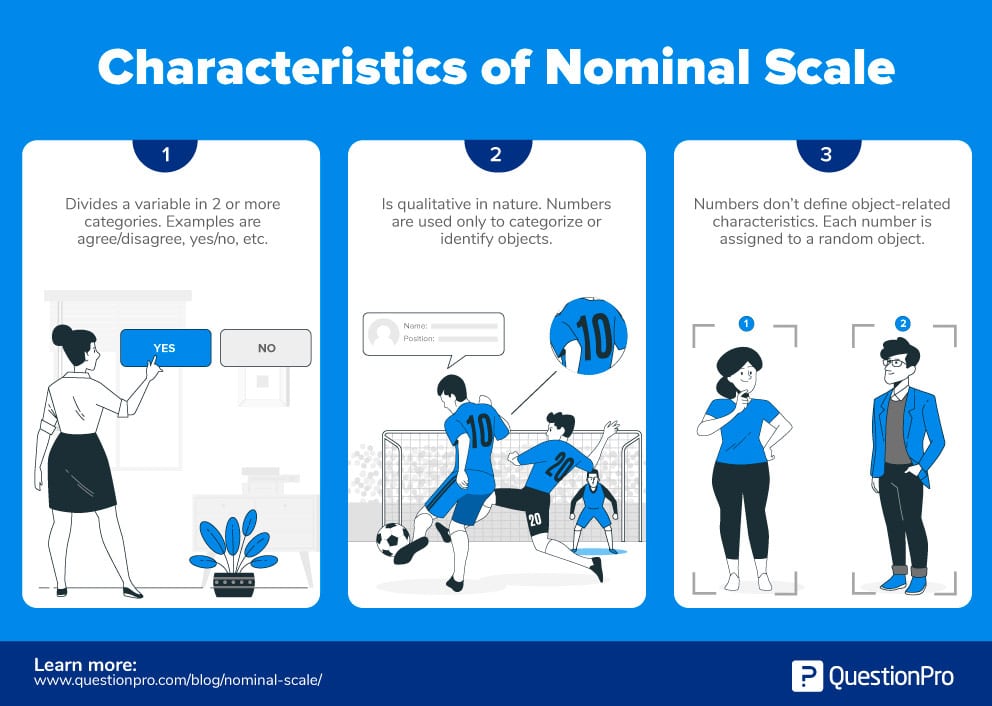
Nominal Scale: Definition
A Nominal Scale is a measurement scale, in which numbers serve as “tags” or “labels” only, to identify or classify an object. This measurement normally deals only with non-numeric (quantitative) variables or where numbers have no value.
Below is an example of Nominal level of measurement.
Please select the degree of discomfort of the disease:
- 1-Mild
- 2-Moderate
- 3-Severe
In this particular example, 1=Mild, 2=Moderate, and 3=Severe. Here numbers are simply used as tags and have no value.
There are four variable measurement scales: nominal, ordinal, interval and ratio. These measurement scales are ways to categorize different variables (an element, feature or factor that is likely to vary). By default, all variables fall in one of the four scales mentioned above. Understanding their properties and assigning variables to one of the four measurement scales is important mathematically because they determine what mathematical operations are allowed.
LEARN ABOUT: Behavioral Research
Nominal scale possesses only the description characteristic which means it possesses unique labels to identify or delegate values to the items. When it’s used for the purpose of identification, there is a strict one-to-one correlation between an object and the numeric value assigned to it. For example, numbers are written on cars in a racing track. The numbers are there merely to identify the driver associated with the car, it has nothing to do with characteristics of the car.
But when nominal scale is used for the purpose of classification, then the numbers assigned to the object serve as tags to categorize or arrange objects in class. For example, in the case of a gender scale, an individual can be categorized either as male or female. In this case, all objects in the category will have the same number, for example, all males can be no. 1 and all females can be no. 2. Please note, that nominal is purely used for counting purposes.
LEARN ABOUT: System Usability Scale
From a statistics point of view this scale is one of the easiest to understand measurement scale. As mentioned earlier, it is assigned to items that are not quantitative or number oriented.
For example, let’s assume we have 5 colors, orange, blue, red, black and yellow. We could number them in any order we like either 1 to 5 or 5 to 1 in ascending or descending order. Here numbers are assigned to colors only to identify them. Another example of nominal scale from a research activity point to view is YES/NO scale. It essentially has no order.
Create a Nominal Scale Survey: Get Your Free Account Now
Characteristics of Nominal Scale
- In nominal scale a variable is divided into two or more categories, for example, agree/disagree, yes or no etc. It’s is a measurement mechanism in which answer to a particular question can fall into either category.
- Nominal scale is qualitative in nature, which means numbers are used here only to categorize or identify objects. For example, football fans will be really excited, as the football world cup is around the corner! Have you noticed numbers on a jersey of a football player? These numbers have nothing to do with the ability of players, however, they can help identify the player.
- In nominal scale, numbers don’t define the characteristics related to the object, which means each number is assigned to one object. The only permissible aspect related to numbers in a nominal scale is “counting.”
Learn more: Quantitative Research
Nominal Scale Examples
Here are some of the examples of nominal measurement that will help in understand this measurement scale better.
- How would you describe your behavioral pattern?
- E-Extroverted
- I-Introverted
- A-Ambivert
- What is your gender?
- M-Male
- F-Female
- Could you please select an option from below to describe your hair color.
- 1-Black
- 2-Brown
- 3-Burgundy
- 4-Auburn
- 5-Other
There is a subtype in nominal scale with only two categories like one of the examples mentioned above: Gender- Male/Female.
Or, do you own an iPhone? The answer could be Yes/No.
This subtype is known as dichotomous nominal scale.
Conclusion
The point of this concluding note in this blog is to keep everyone informed, that the classification of variables according to their measurement is useful in concluding which analytical procedure is useful for a researcher.
LEARN ABOUT: Average Order Value
In this scale, it is easy to generate responses using close ended questions, a lot of responses can be collected in short period of time, which in turn increases reliability. However, there is a downside to the scale, without a linear scale, participants are unable to express their degrees of response.
Learn more: Types of survey questions with answers
Read more about different variable measurement scales:
Create a Nominal Scale Survey: Get Your Free Account Now









